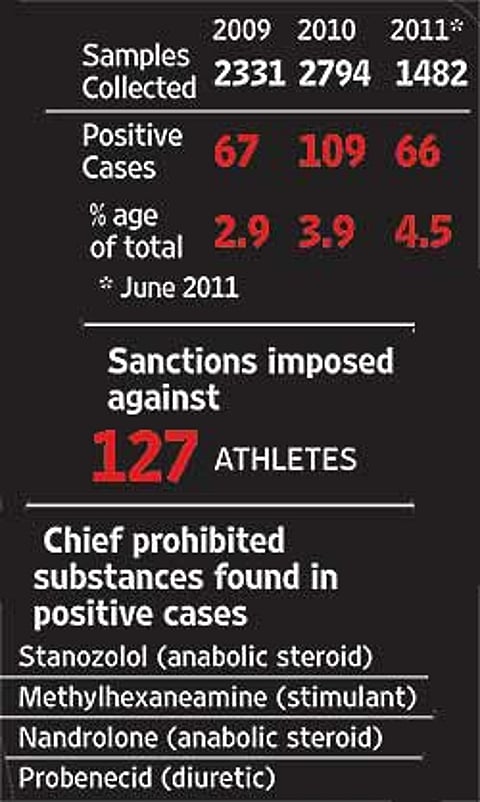Mainlined To The End Of The Sprint
The finding that three of our best were doped shames us. Few are surprised.
Today, that same frame has returned to shame us. The revelation that three of the four gold-winning girls of the 4 x 400 metres relay team at the Commonwealth Games and the Asiad—Mandeep Kaur, Ashwini Akkunji and Sini Jose—had tested positive for banned drugs during routine tests recently has soiled India’s track record. Samples from five other athletes were also found tainted. Most of them tested positive for methandienone, an anabolic steroid (or muscle-builder) that’s on the list of drugs banned by the World Anti-Doping Agency (WADA). Had the three consumed it to win the feted gold medals? It’s a question that many Indians probably wish is best left unanswered.
The rot in Indian sports runs deep, as figures from the National Anti-Doping Agency (NADA) in India reveal. Ever since NADA began testing samples on a regular basis in January 2009, the percentage of athletes testing positive has been increasing. In 2009, 67 out of 2,331 (2.87 per cent) samples were found to contain prohibited substances; in 2010, that figure was 109 out of 2,794 (3.9 per cent). In 2011, 66 out of 1,482 samples (4.45 per cent) have tested positive so far.
What went wrong in the case of the three girls? After repeated attempts, Outlook managed to contact Mandeep Kaur on phone. She blamed food supplements for the methandienone found in a sample collected from her. “The Ukrainian coach got us ginseng from China, and then, along with our other coaches, we went to buy some supplements from a store in Patiala,” says Kaur. She didn’t recollect any of the brand names she had consumed and said the “one protein and two vitamin supplements” the Sports Authority of India (SAI) provides are not enough. “SAI never tells us what not to buy,” she says. Asked further questions, she hung up.
But P.S.M. Chandran, president of the Indian Federation of Sports Medicine, isn’t convinced with the defence proffered by the athletes. “If the contamination originated from a food sample, let them produce it for testing,” he says outright. “Did they unknowingly buy something contaminated from outside the camp, despite the fact that they are not allowed to buy anything from outside? Or did they buy it fully knowing that it would enhance their performance? Either way, they are guilty,” Chandran adds. Rules framed by the WADA and adhered to by NADA clearly hold athletes “responsible whenever a prohibited substance is found in their bodily specimen”. Which is why former athlete Anju Bobby George says athletes ought to be extremely careful of what they consume. “If athletes are buying vitamins and other food supplements, they should only buy the best brand. I was tested as many as 14 times in a year but was never found to be positive,” she says.
This latest episode has also brought the role of coaches under scrutiny. The fired coach of the 4 x 400 metres relay team, Yuri Ogrodnik, also blames food supplements. “I’m not a fool to tell athletes to buy and consume something that’s in the WADA list. I have given only medals and not steroids,” he told the media, defending his position. Nonetheless, sports minister Ajay Maken has sacked all foreign coaches in a desperate bid to clean up Indian athletics. Most of these coaches come from Ukraine and countries that comprised the former Soviet bloc, a region reputed to have developed a hard-to-detect system of doping from the days of the Cold War rivalry between the US and ussr that played out at international sports meets.

Rahul Bhatnagar, director general of NADA, acknowledges that coaches are a weak link. “Never at our disciplinary hearings does an athlete say the coach gave them the drug. It is a special relationship they have,” he says. “We have therefore asked the employers of the coaches to keep a strict vigil on them and ensure action is taken if they are found guilty of any wrongdoing.” Another area of investigation is how the same substance shows up en masse at the same time in many athletes from different locations. In June-July last year, it was methylhexaneamine; now it is methandienone. “It could be that the contamination comes from one particular brand of food supplement available in the market at that time and which everyone happens to be taking,” says Bhatnagar.
But it isn’t as if all sportsmen are really stunned to discover they have tested positive; some just are unlucky to be caught. As the prize money and fame in sports grows, the temptation to ingest performance-boosters too has grown. It takes little more than a short walk from the Netaji Subhas National Institute of Sports in Patiala, where our best athletes train, to the chemist’s to buy prescription drugs over the counter. Beyond their public performance under a stadium’s floodlights, some athletes are also known to indulge in a different sport—a cat-and-mouse game in which they try and evade representatives from NADA. Bhatnagar says some athletes just disappear from a camp when they hear of the impending arrival of sample collectors, an absence that is later explained with a leave certificate. “In that case, at least the certificate should not be dated as the same day as our arrival at the camp,” he adds. Many have switched to more advanced drugs that are flushed out of the body much quicker to avoid detection; some use masking agents that help conceal the presence of banned substances.
As NADA scales up its operations and increases the number of collected samples in time for the London Olympics in 2012, one hopes there aren’t more skeletons waiting to tumble out of India’s locker rooms.
Tags